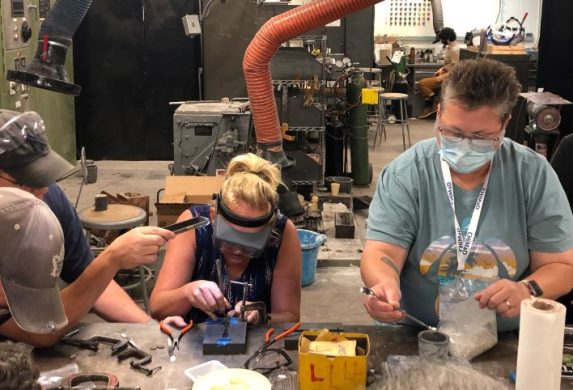
Ten high school teachers spent a week at MIT in July designing and making Frankensteel, a self-healing material inspired by the villain in the Terminator 2 movie. Next up: they aim to re-create the calculations and experiments involved for their students back home.
“This was a phenomenal experience for me, and inspirational in terms of ‘way cool possible careers/fields of study’ for students,” wrote one teacher in response to an anonymous survey at the end of the week.
Introducing materials engineering
About twenty years ago the world’s largest society involving materials, ASM International, began holding annual Materials Camps to introduce high-school students—and, a few years later, their teachers—to the world of materials science and engineering. They did so in part because “high-school students seemed to have a basic understanding of every field of engineering except materials,” says Gregory B. Olson, who has been involved in the camps for many years.
Olson, who recently joined MIT’s Department of Materials Science and Engineering (DMSE) as the Thermo-Calc Professor of the Practice, led the recent Materials Genome Camp at MIT. This is the first time such a camp has been held at the Institute.
During the camp, teachers were introduced to the Materials Genome Initiative (MGI), which President Barack Obama announced in 2011. As Olson explains, it is an effort to create a “fundamental database of the parameters that direct the assembly of the structures of materials,” much like the Human Genome Project “is a physical database that directs the assembly of the structures of life.”
The goal is to use the database to design, manufacture, and deploy advanced materials twice as fast and at a fraction of the cost compared to traditional methods, according to the MGI web site. The MGI “acknowledged that the kinds of computational materials design we have been practicing is real and ready, and it’s what everybody should be doing,” says Olson, who was a co-founder of the first center formed to jumpstart the effort, which is funded by the National Institute of Standards and Technology as the multi-institutional “CHiMaD” Center for Hierarchical Materials Design.
Making Frankensteel
The teachers at MIT worked with Thermo-Calc, computational software used to predict materials structures (each went home with a free copy). They used it to design four different versions of Frankensteel, the material inspired by the villain in Terminator 2 whose metal body can take a hit then repair itself. “We wanted to focus on something that would really excite students,” says Olson, whose continuing CHiMaD research is supported through the MIT Materials Research Laboratory.
Frankensteel is composed of a metal alloy supported by a network of wires made of a shape-memory alloy (materials that undergo a reversible change in structure when exposed to heat). If the composite material cracks, it can “heal” itself when heated to a certain temperature. “It essentially solders itself at that temperature,” Olson says.
For the camp, the teachers first designed four versions of a tin alloy rather than the iron alloy used in commercial Frankensteels. “It’s a simplified version that can be made in a high-school chemistry lab,” Olson says. They also calculated how many wires are necessary in each composite.
Then they made and tested the materials.
The entire process can be done in a high-school chemistry lab, Olson says, with the exception of the final testing. “The testing is the biggest challenge in moving [the demonstration] to the schools” due to the equipment involved. Olson notes, however, that schools can sometimes collaborate with local universities to use their equipment. “We continue to explore other ways that the teachers can conduct the tests,” Olson says. “One of the faculty who’s been involved in these camps for a long time has even come up with a wood-based tensile tester that you can build yourself, and operate by turning a crank.”
Materials Camp also included several guest lectures, including one by Professor Christopher Schuh, the Danae and Vasilis Salapatas Professor of Metallurgy and a former head of DMSE. Several other MIT people were also involved in Materials Camp. Technical Instructors Shaymus Hudson and Mike Tarkanian shared their laboratories and instructed the teachers in casting and testing their samples. DMSE graduates students Krista Biggs, Clay Houser, and Julian Rackwitz, and Research Associate Dr. Margianna Tzini, helped coordinate the overall week.
Concludes Biggs: “We had an enthusiastic, curious group of teachers working on an interesting project, and it was a very fulfilling week.”
In addition to its ASM International affiliation, the MIT Materials Genome Camp was financially supported as an outreach activity of the NIST-funded CHiMaD Center.